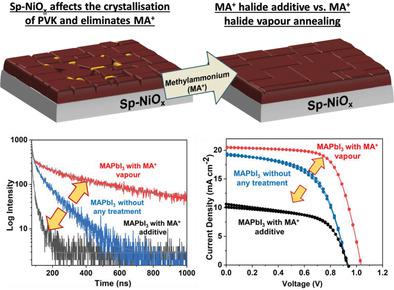当前位置:
X-MOL 学术
›
Adv. Mater. Interfaces
›
论文详情
Our official English website, www.x-mol.net, welcomes your feedback! (Note: you will need to create a separate account there.)
Investigating the Growth of CH3NH3PbI3 Thin Films on RF‐Sputtered NiOx for Inverted Planar Perovskite Solar Cells: Effect of CH3NH3+ Halide Additives versus CH3NH3+ Halide Vapor Annealing
Advanced Materials Interfaces ( IF 5.4 ) Pub Date : 2019-12-20 , DOI: 10.1002/admi.201901748 Namrata Pant 1 , Ashish Kulkarni 2 , Masatoshi Yanagida 1, 3 , Yasuhiro Shirai 3 , Tsutomu Miyasaka 2 , Kenjiro Miyano 3
Advanced Materials Interfaces ( IF 5.4 ) Pub Date : 2019-12-20 , DOI: 10.1002/admi.201901748 Namrata Pant 1 , Ashish Kulkarni 2 , Masatoshi Yanagida 1, 3 , Yasuhiro Shirai 3 , Tsutomu Miyasaka 2 , Kenjiro Miyano 3
Affiliation

|
Investigating the low efficiency issue of radio frequency‐sputtered nickel oxide (sp‐NiOx)‐based perovskite solar cells (PSCs) due to a limited understanding of the correlation between perovskite growth and sp‐NiOx on the optoelectronic properties and photovoltaic device performance is critical. Herein, the crystallization of methylammonium (MA) lead iodide (MAPbI3) thin film (obtained from stoichiometric precursor ratio) on sp‐NiOx is shown, resulting in appearance of residual PbI2 grains. This is in contrast to perovskite growth on solution‐processed NiOx. The amount of residual PbI2 is suppressed by 1) adding excess MACl/MAI additives and 2) annealing the perovskite film in MACl/MAI vapor atmosphere. Structural and morphological results reveal significant reduction in the amount of residual PbI2 and enhanced grain size for all the cases while photophysical measurements reveal mitigation of trap/defect sites (within the bulk and at the interfaces) only for MACl/MAI vapor annealing case. As a result, photovoltaic devices exhibit improved performance only for the vapor annealing case. These results elucidate the critical role of maintaining stoichiometric ratio in perovskite and its crystallization on sp‐NiOx by eliminating the associated defects (influenced by sp‐NiOx) in rendering improved performance, which can be insightful to further enhance the performance of PSCs.
中文翻译:

研究用于反向平面钙钛矿太阳能电池的RF溅射NiOx上CH3NH3PbI3薄膜的生长:CH3NH3 +卤化物添加剂与CH3NH3 +卤化物蒸汽退火的影响
由于对钙钛矿生长与sp-NiO x之间在光电性能和光伏器件性能之间的相关性的了解有限,因此研究了基于射频溅射氧化镍(sp-NiO x)的钙钛矿太阳能电池(PSC)的低效率问题至关重要。此处显示了在sp‐NiO x上甲基铵(MA)碘化铅(MAPbI 3)薄膜的结晶(从化学计量的前体比获得),导致出现了残留的PbI 2晶粒。这与固溶处理后的NiO x上钙钛矿的生长形成对比。残留PbI 2的量通过1)添加过量的MAC1 / MAI添加剂和2)在MAC1 / MAI蒸气气氛中对钙钛矿膜进行退火来抑制这种情况。结构和形态学结果表明,在所有情况下,残留PbI 2的数量均显着减少,晶粒尺寸增大,而光物理测量结果表明,仅在MAC1 / MAI气相退火的情况下,捕集/缺陷位点(在主体内和界面处)得到了缓解。结果,光生伏打器件仅在蒸气退火的情况下表现出改进的性能。这些结果阐明了通过消除相关的缺陷(受sp-NiO x影响)在钙钛矿中保持化学计量比及其在sp-NiO x上结晶的关键作用。)以提高性能,这对于进一步提高PSC的性能很有帮助。
更新日期:2019-12-20
中文翻译:

研究用于反向平面钙钛矿太阳能电池的RF溅射NiOx上CH3NH3PbI3薄膜的生长:CH3NH3 +卤化物添加剂与CH3NH3 +卤化物蒸汽退火的影响
由于对钙钛矿生长与sp-NiO x之间在光电性能和光伏器件性能之间的相关性的了解有限,因此研究了基于射频溅射氧化镍(sp-NiO x)的钙钛矿太阳能电池(PSC)的低效率问题至关重要。此处显示了在sp‐NiO x上甲基铵(MA)碘化铅(MAPbI 3)薄膜的结晶(从化学计量的前体比获得),导致出现了残留的PbI 2晶粒。这与固溶处理后的NiO x上钙钛矿的生长形成对比。残留PbI 2的量通过1)添加过量的MAC1 / MAI添加剂和2)在MAC1 / MAI蒸气气氛中对钙钛矿膜进行退火来抑制这种情况。结构和形态学结果表明,在所有情况下,残留PbI 2的数量均显着减少,晶粒尺寸增大,而光物理测量结果表明,仅在MAC1 / MAI气相退火的情况下,捕集/缺陷位点(在主体内和界面处)得到了缓解。结果,光生伏打器件仅在蒸气退火的情况下表现出改进的性能。这些结果阐明了通过消除相关的缺陷(受sp-NiO x影响)在钙钛矿中保持化学计量比及其在sp-NiO x上结晶的关键作用。)以提高性能,这对于进一步提高PSC的性能很有帮助。



























 京公网安备 11010802027423号
京公网安备 11010802027423号